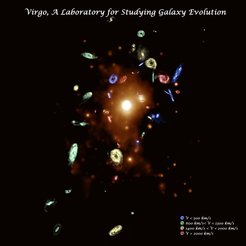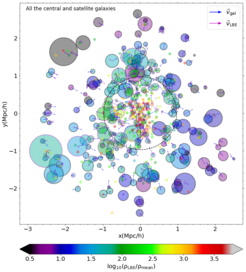Galaxy physics beyond the halo boundary
Models of the large-scale structure of galaxies in the Universe suffer from serious limitations, when artificial boundaries are imposed at the virial radius of the dark matter halo. As MPA scientists demonstrate, environmental effects vary smoothly across the traditionally adopted halo boundary and need to be taken into account even in low-density environments.

Our understanding of the formation and evolution of galaxies has improved significantly during the past few decades. On the theoretical side, numerical simulations have been key to elucidating how large-scale structure in the dark matter component of the Universe emerges in the form of a cosmic web of filaments, sheets, and clusters of galaxies surrounding large under-dense regions, or voids. Galaxies form at the intersections of filaments and sheets, where gas reaches high enough densities so that particle interactions cause it to cool, to lose pressure support, and to collapse to form stars.
Computer simulations that include the hydrodynamics of gas are computationally very expensive. A well-defined, computationally efficient way to apply the theory of galaxy formation to a very large volume of the Universe is to use semi-analytical models. Such a semi-analytical model applies a set of equations describing the main physical processes influencing galaxies to a set of halo merger trees extracted from the simulation. These halo merger trees document, which collapsed structures, or halos, merge with each other as structures in the Universe build up under the influence of gravitational forces. Combining these with the semi-analytic models allows predictions for the observed properties of galaxies as a function of cosmic epoch.
After the gas has cooled and collapsed under gravity to form a centrifugally supported disk galaxy within a dark matter halo similar to our own Milky Way, environmental processes can influence the subsequent evolution of the system. Direct observations have shown that the properties of galaxies depend on the environment in which they reside. The morphology-density relation derives from the observed fact that galaxies in massive clusters are more likely to be non-star-forming (or quenched). In such dense environments, gravitational tidal effects on galaxies become strong and this strips dark matter and stars from their outer regions. In physics, a body moving through a fluid medium is subject to ram pressure, where the relative bulk motion of the fluid exerts a drag force on the body. In galaxy groups and clusters, ram-pressure forces become strong enough to overcome the gravitational binding energy of the gas, so that the gas is stripped out of the galaxy and star formation ceases.

An important question that has largely been neglected up to now is the radius from the cluster or group centre where these effects start to become important. Most analytic and semi-analytical models of galaxy formation, including our in-house model, L-Galaxies, adopts the virial radius as the boundary beyond which environmental effects are no longer important. However, a number of observational studies have suggested that environmental processes may influence gas and star formation in galaxies well beyond this radius. For example, so-called galactic conformity effects, the observed large-scale correlation between star formation in neighbouring galaxies, extends out to distances of several megaparsec, which is much larger than the virial radius of even the most massive clusters. In addition, hydrodynamical simulations suggest that the shock-heated gas of a dark matter halo can extend beyond its virial radius.

A realistic and accurate model of galaxy formation and evolution needs to contain prescriptions for environmental effects for all galaxies in a simulation. We have developed a new way to measure the properties of the Local Background Environment (LBE), including its density and bulk motion, for every galaxy in the Millennium Simulation. The local background properties are measured in a spherical shell around each galaxy. Care must be taken to deconvolve simulation particles that are truly part of the background from those which are gravitationally bound to the galaxy. As an example, Figure 2 shows the velocity distribution of the particles in the shell of one of the galaxies in the simulation. This is formed by two Gaussians, therefore, the deconvolution of the particles (into background and bound particles) is possible using Gaussian mixture modelling techniques.
In our work, we have analysed the properties of the local background as a function of distance from the group/cluster centre. We show that there is no abrupt change in density or bulk velocity at any radius, indicating that environmental effects vary smoothly across the traditionally adopted halo boundary. Preliminary results indicate that gas stripping may also play an unexpectedly important role in some galaxies in low-density environments, particularly those accelerated by a previous, close encounter with another galaxy, or those falling through parts of the cosmic web. In future work, we will explore the implications of these findings for cosmological studies of galaxy surveys, as well as for models for the formation and evolution of galaxy properties.














